(ZENIT News / Melbourne, 05.07.2022).- The Australian Government published the statistics regarding the religious census of the country’s population, a fact that is part of the census survey since 1911. Among the most important facts is that of the decline of Christianity in over one million people, although it continues to be the most common religion in Australia. Other Confessions continue growing, due in good measure to migration. This reflects the fact that Australia is becoming a more diverse country religiously. On the other hand, almost 10 million Australians say they have “No Religion.”
Religious Affiliation in 2021
In 2021 more people opted to respond to the Census’ question of religion than in 2016. In 2021, the amount of people that answered the question on religion was 93.1% of the population, an increase of 90.9% than in 2016.
In 2021 the most common religions were:
Christianity (43.9%)
No Religion (38.9%)
Islam (3.2%)
Hinduism (2.7%)
Buddhism (2.4%)
Change in Religious Affiliation Over Time
Over the last 50 years, there has been a constant decrease in the proportion of Australians that reported an affiliation with Christianity. The same period has witnessed a constant increase in “Other Religions” and “No Religion,” particularly over the last 20 years.
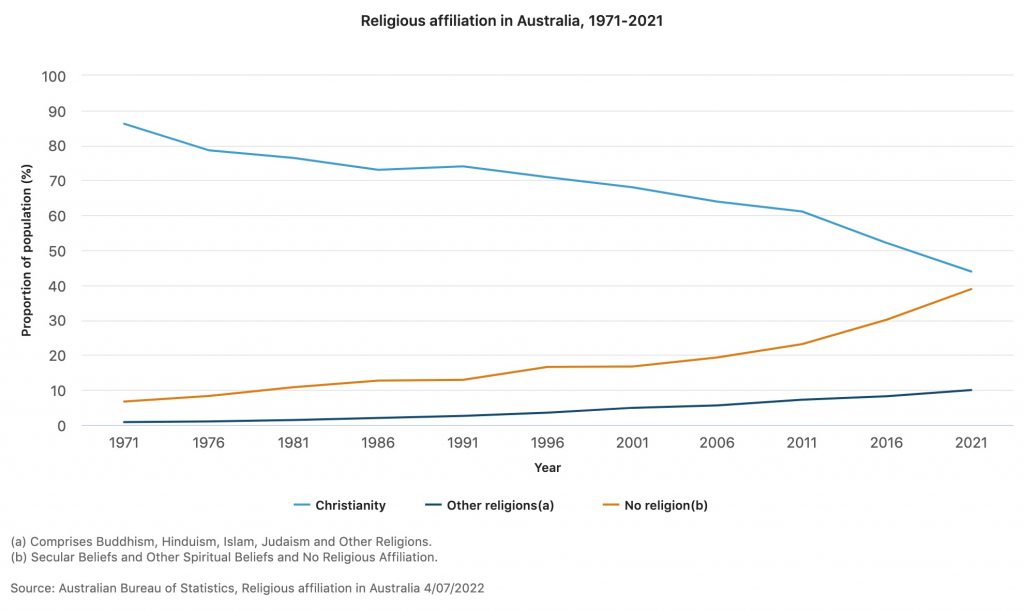
Migration and Religious Affiliation
Australia’s religious profile has been moulded by migratory waves. The British introduced Christianity at the end of the 18th century. Another migration to Australia, which has probably impacted the religious scene, includes:
- 1800 and early 1900: free British and Irish settlers
- 1940 and 1950 decades: Migrants from Europe after World War II
- 1960 decade: Refugees from the Middle East
- 1970 decade : Refugees from the Asian Southeast
- 2000 decade: Humanitarian entries from Africa and the Middle East; qualified immigrants from the Northeast and South of Asia.
The tendency of increase of “Other Religions” and “No Religion” in Australia is reflected in the religious affiliation of immigrants that have arrived since the last Census.
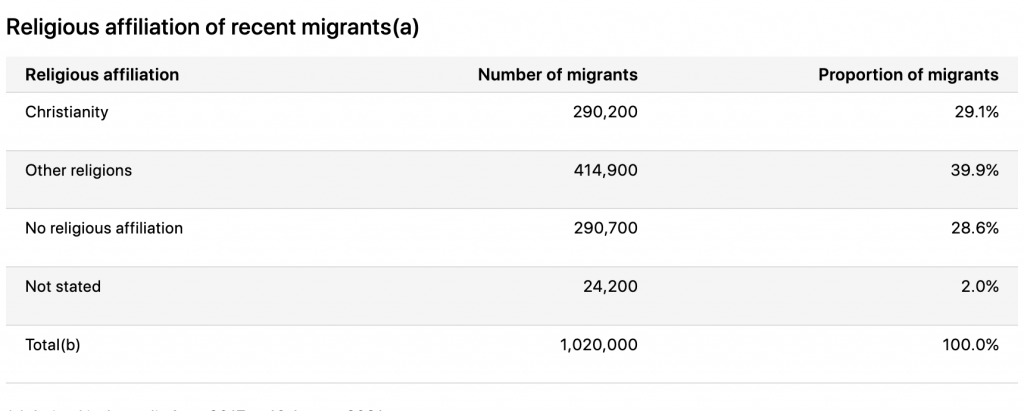
Christian Affiliation by Generation
The Christian affiliation of people in Australia varied from generation to generation. In general, the older generations had greater probabilities of being affiliated to Christianity and the younger generations had more probabilities of not having a religious affiliation.
For instance, more than two-thirds (69.4%) of the generation between the Wars were affiliated to Christianity and were the least inclined to have “No Religion” (18.6%).
The millennials had the greatest proportion of “No Religion” (46.5%) and “Other Religions” (14.9%). This reflects the age profiles of these religions. For example, the average age for Hinduism was 31 years, for Sikhism 30 years and for Islam 28 years.
The religious affiliation of the X Generation was closely aligned with the proportions of the Australian population in general.
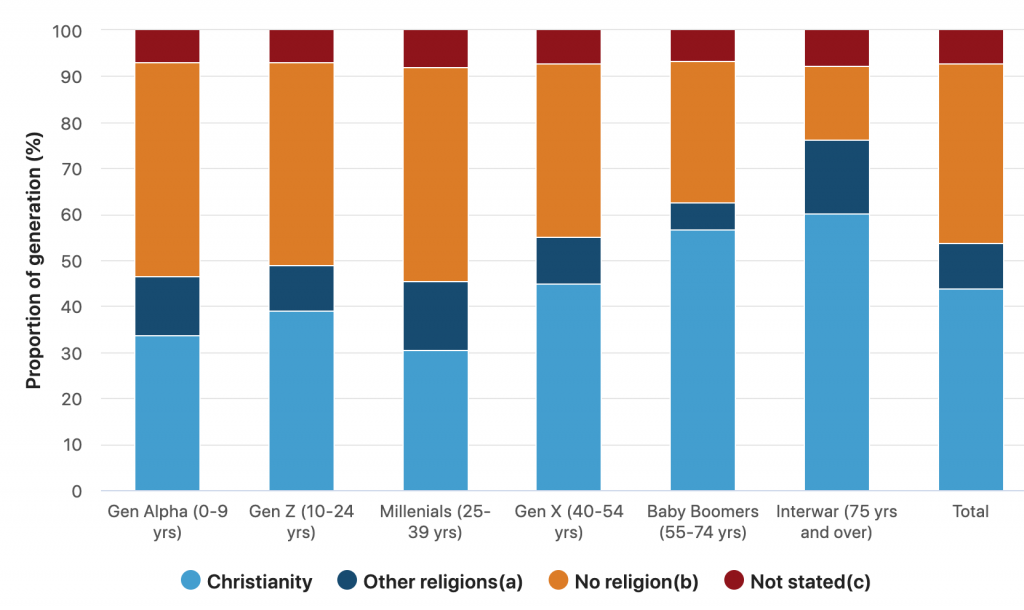
Decline in Christian Affiliation
The number of people affiliated to Christianity in Australia decreased from 12.2 million (52.1%) in 2016 to 11.1 million (43.9%) in 2021. This decrease took place in the majority of ages, with the greatest decrease among young adults (18-25 years old).
Anglicanism and Catholicism have been and are Australia’s largest denominations. In 2021, the amount of people that informed each one of these denominations decreased and represents the greater part (78%) of the decrease of affiliation to Christianity.
In 2021 Catholicism decreased by 20% (from 22.6% in 2016). Although this figure has been decreasing over time, the decrease has been halted by immigration to regions with a high number of followers of Catholicism, as the Asian Southeast and South America.
Of all the immigrants that arrived in Australia between 2016 and 2021, almost 200, 000 (191,000) reported their affiliation to Catholicism in the 2021 Census, of which more than a quarter were born in the Philippines.
The Anglican Church (called the Church of England until 1981) was the main religious denomination in Australia during the 19th and 20th centuries. In the 1911 Census, 38.4% of the population reported being affiliated to the Church of England. This proportion remained constant during the first half of the 20th century, stimulated by the constant British migration to Australia. The 1954 Census reported that 37.9% of Australians were affiliated to the Church of England.
Over the last 50 years, this proportion has decreased constantly. In 1986, the proportion of Anglican affiliation (23.9%) fell below the Catholic affiliation (26.1%). In 2006, the Anglican affiliation (18.7%) was surpassed by those that stated they had “No Religion” (19.4%).
From 2016 to 2021, the Anglican affiliation suffered the greatest decline in number of all the religious denominations: from 3.1 million to 2.5 million people. This was a decrease of almost one out of five Anglicans (19.5%), from 13.3% to 9.8% of the population.
The average age of people of Anglican affiliation in 2021 was 56 years, as compared to 47 years of Christians in general.
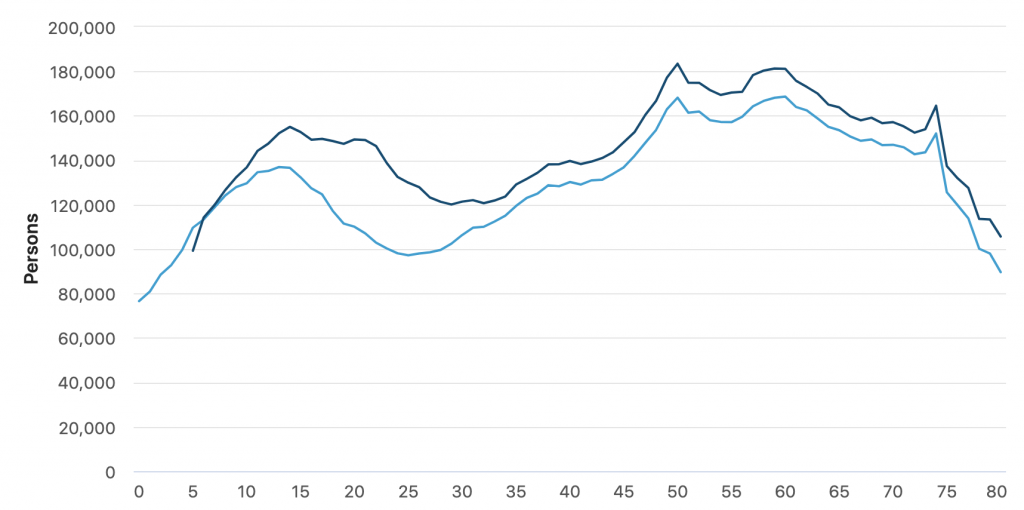
Heyday of Non-Confessional Christianity
Not all the Christian denominations are declining. From 2016 to 2021, the highest increase was in the answers codified in the complementary category “Christianity nfd (not further defined).”Christianity nfd” includes answers that contain enough information to be codified as Christianity but not as a specific denomination. In 2021, the majority of this group were people who answered “Christian” or “Christianity” to the religion question.
In 2021, there were almost 700,000 people in the category “Christianity nfd” category (688,400), an increase of 75,000 since 2016 (76,100). The constituted 2.7% of Australians, the same proportion as that affiliated to Hinduism.
“Christianity nfd” was included for the first time as a group in the 1996 Census, when the Australian Classification Standard was developed of religious groups (ASCRG). Since then, the number of answers in this category has increased from 181,900 (1.0% of Australians) in 1996.
An increase in this group can indicate a growing tendency of people that are more broadly affiliated to Christianity than to specific Christian denominations.
From 2016 to 2021, other Christian denominations that increased included Orthodox denominations. These denominations grew in Australia in the second half of the 20th century due to the migration after World War II from Eastern Europe. They are common to people with Greek, Lebanese and Serbian ancestry. The largest of these denominations, the Greek Orthodox, represented 1.5% of Australians in 2021.
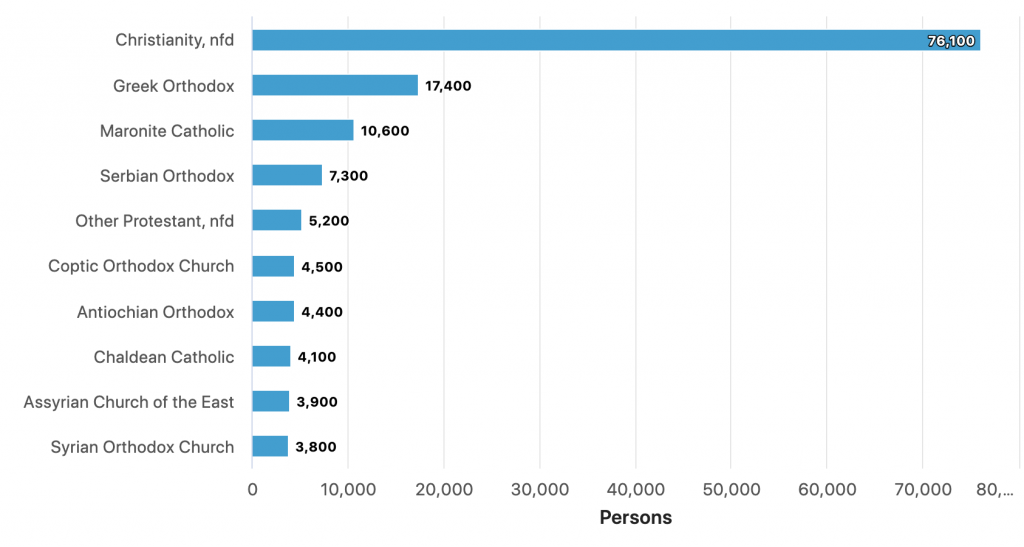
Growth in Affiliation to Other Religions
In 2021, more than 2.5 million people reported affiliation to other religions. This was an increase of over 600,000 (617,800) since 2016.
In the last 25 years, the proportion of people that say they are affiliated to other religions grew from 3.5% in 1996 to 10% of the population in 2021 This growth has accelerated especially since 2006.
These increases reflect Australia’s migratory tendencies. In 2021, 93.8% of people affiliated to religions were born abroad or had at least one parent born abroad
In 2021, the other main religions in Australia were Islam, Hinduism and Buddhism.
Data on Buddhism was published for the first time in the 1981 Census, in response to the arrival of a large number of Buddhists as Vietnamese refugees in the decade of 1970. Since then, a constant increase has been maintained due to a large extent to the migration from the Asian Southeast, China and Sri Lanka.
Although the number of Buddhists continues increasing in 2021 the main contributors to the increase of other religions were:
Hinduism (243,700)
Islam (209,150)
Sikhism (84,500)
These increases were due in great measure to the recent migration from South and Central Asia.
Of the immigrants that arrived in Australia between 2016 and 2021, 210,000 were affiliated to Hinduism. The majority of these immigrants (91.9%) were born in India and Nepal.
Likewise, almost 60,000 (57,300) recent immigrants were affiliated to Sikhism, and almost all (95.9%) were born in India. Sikhism has grown in Australia particularly. Over the last 10 years. The number of people affiliated to Sikhism has almost trebled since the 2011 Census. In 2021, they constituted 0.8% of the population (210,400 people).
The increase in Islamic affiliation can also be attributed in great measure to the recent migration. Almost 126,000 people who arrived in Australia between 2016 and 2021 were affiliated to Islam. The main countries of birth were Pakistan, Afghanistan, India and Bangladesh.
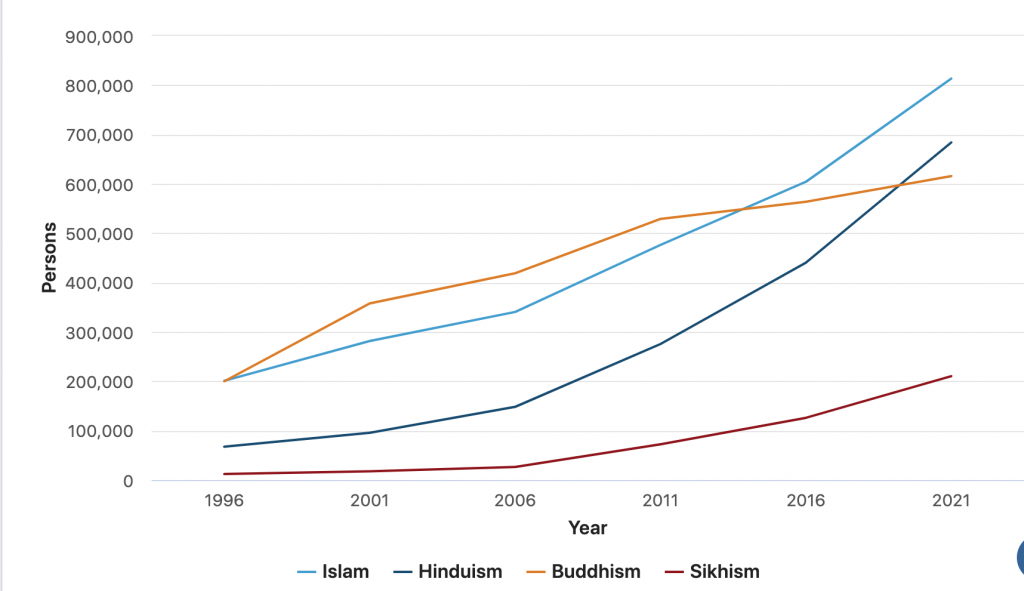
Change in “No Religion” Over time
Religious liberty is an important value in Australian society. People are free to choose, express and practice their religious beliefs in different ways. This includes the right not to profess a religion or creed.
In all Censuses since 1911, a proportion of people have answered that they had no religious affiliation. The questionnaire of the 1911 Census asked every individual to state his religion. People could answer that they had “No Religion” if they were “freethinkers, or if they had no denomination or religion.” In 1911 more than 10,000 people stated they had “No Religion.” This was 0.2% of the population.
Over time, we have changed the way in which we present the option “No Religion” in the question on religion. Modifications have been made to reflect the changes in Australia’s religious profile, as well as in the answer to the public consultation. These include:
1971: The first Census with instructions in the questionnaire: If you have “No Religion” write none.
1991: The first Census with a list of boxes of verification of religions, one option for the free text and a verification box for “No Religion” at the end of the list.
2016: The option of the answer “No Religion” was moved from the last to the first answer option in the Census’ questionnaire
These changes could have affected the number of answers “No Religion.” For instance, the proportion of the population that reported they had “No Religion” increased from 0.8% in 1966 to 6.7% in 1971, when instructions were added to the question on religion.
“No Religion” in 2011
From 1971 to 2021, the proportion of people that reported they had “No Religion” increased constantly.
In 2021 the proportion was 38.9%, an increase of 30.1% in 2016, which represents an increase of more than 2.8 million people. This increase indicates a distancing from the religious and spiritual points of view, either by expressing their beliefs outside the traditional religious institutional frameworks or not having a religious or spiritual point of view to express.
The majority of the answers in the broad category Secular Beliefs and Other Spiritual Beliefs and No Religious Affiliation were in the sub-category “No Religion,” described thus. The remaining sub-categories represent only 1.2% of the answers.
“No Religion” by Age
An increase of people that reported not having a religion in 2021 indicates that some people have ceased to be affiliated to a religion since the last Census in 2016.
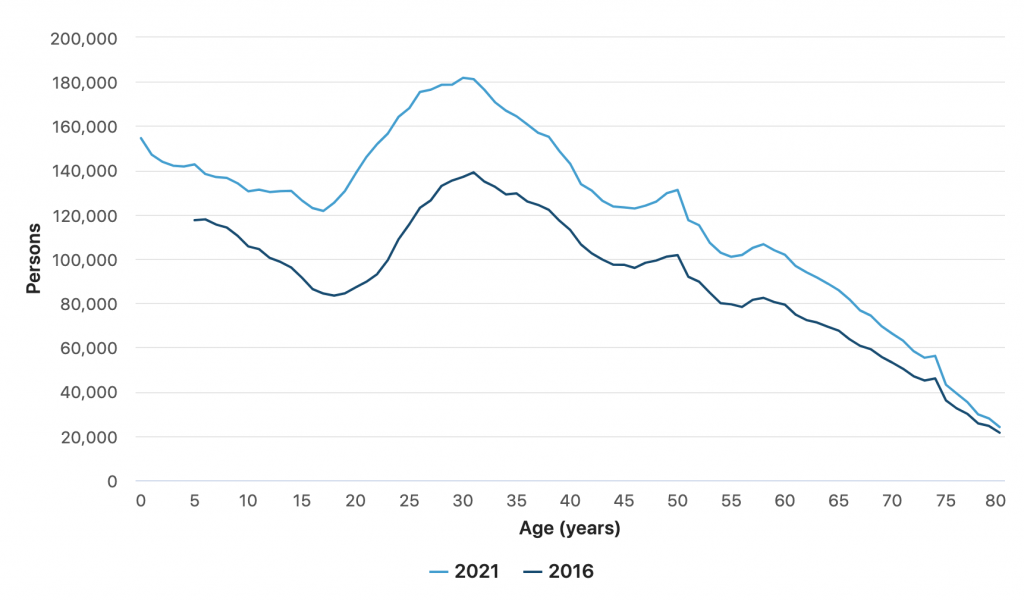
An increase in the number of people who reported having “No Religion” between 2016 and 2021 was higher for young adults, particularly the twenty-year-olds. In general, the probability of people that cease to be affiliated to a religion decreases with age.
The people who reported to have “No Religion” were younger than the people affiliated to Christianity. In 2021, almost half (48.4%) of the people between 25 and 34 years of age reported having “No Religion.” However, since 2016 the average age of this group increased from 31 years to 33 years.
In 2021, whereas the proportion of people that reported having “No Religion” increased in all age groups, the highest proportional increase was for people 65 years or older. This was an increase of almost 600,000 (592,000) to slightly more than one million people. Despite this change, in 2021 almost two-thirds (64.2%) of people of this age group were affiliated to Christianity.
With information of the Government of Australia.



